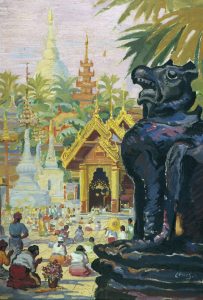Collecting Stories about Art
The Modern and Contemporary Curator shares the excitement of uncovering stories hidden within the Government Art Collection
A trip down memory lane with Dr Claire FitzGerald
My interest in art started early in childhood, when I poured over picture books and illustrated fairy tales, and looked at reproductions of great paintings in my grandfather’s volumes on the French Impressionists. Art always seemed to be embedded in stories in the books I read, but also in all the stories that I would make up when I looked at these images. The ultimate experience, aged nine, was being taken to my first art museum ever, The National Gallery, where I discovered that you could actually walk through whole rooms filled with tales about art.
As a curator at the Government Art Collection I get privileged access to the treasure trove of stories hidden away in our paper archive, which document the life of all the embassies where we’ve hung art, and also to the stories hiding within the pigments of our paintings. But how is this relevant to my job? Since the 1980s, every artwork that the Collection sends out comes with some information about its subject and its maker, which the curators research and compile. Over the years we have accumulated a hoard of knowledge, the result of much labour from curators past and present. Our website is a way for us to share some of our findings.
It’s an ongoing project, and there are a number of artworks in the Collection whose stories remain to be revealed. Here is one anecdote that I’ve particularly enjoyed piecing together:

Unknown Artist, King George V (1865-1936) Reigned 1910-36, c.1910–1930
Tasked with preparing some information about the artworks that had been installed at the Embassy in Yangon, Myanmar, I came across a bit of intrigue in the form of an early 20th century sculpture of King George V (1865–1936) by an unknown artist. How did the statue enter our Collection? And why had it been picked for Myanmar? I wasn’t expecting to necessarily find full answers to my questions – but I definitely wasn’t anticipating what I uncovered in the archives.
Here was a voice from the past in the form of a letter dated 28 November 1980 from Ambassador, Charles L. Booth (1925–1997) addressed to Foreign Secretary, Peter Carrington, the Rt Hon Lord Carrington (1919–2018) presenting a ‘tale of two statues’ – one of them the George V bust in question.

Reginald Henry Lewis, Shwedagon Pagoda, Rangoon, with Worshippers, c.1940–1950
The sculpture had, Ambassador Booth believed, ‘…shipped here shortly after the setting up of the Embassy in 1947 and stood for many years on a marble pillar on the spot where Sir Arthur Payne now stands. It was however missing when I returned to Burma two and a half years ago.’ Upon asking the butler if he knew of its whereabouts, the Ambassador was told that ‘the gardener was dusting it and knocked his nose off.’ Booth’s predecessor, Terence J. O’Brien (1921-2006), had then made the odd decision to have it buried in a corner of the garden. After digging it up, Booth reported that he had ‘…sent it to a marble worker at the Shwe Dagon [sic.] Pagoda, with several photographs of King George to see whether a new nose can be carved and invisibly and firmly affixed.’
It is unclear what came out of Booth’s enquiry at the Shwedagon Pagoda but a report on the condition of the artwork dated 2000, indicates that the nose, ears, and areas of the braiding on King George V’s uniform had been done up in plaster. Whether this was a temporary measure, or the outcome of the 1980 restoration, persists as a mystery.
The bust of the King (and his nose) remain on display in the Embassy’s garden in Yangon today.
Written by Dr Claire FitzGerald, Curator (Modern and Contemporary)


